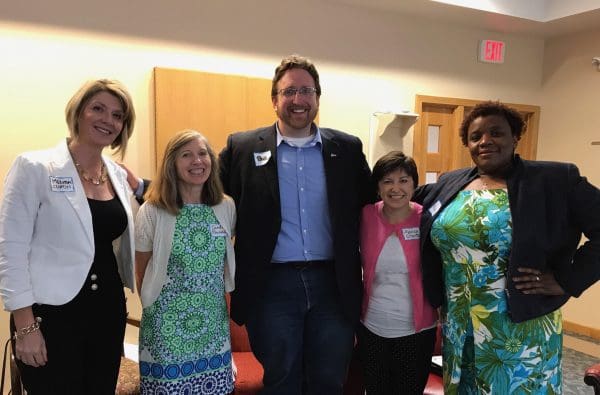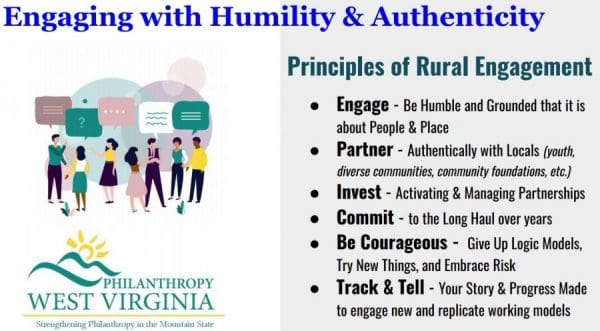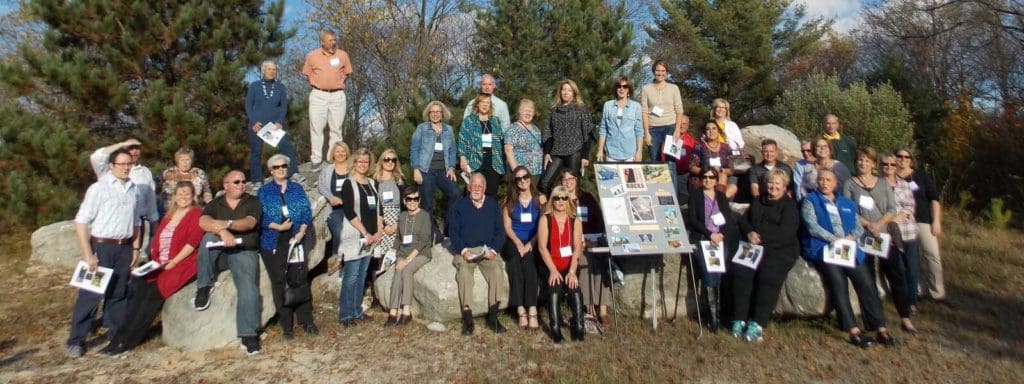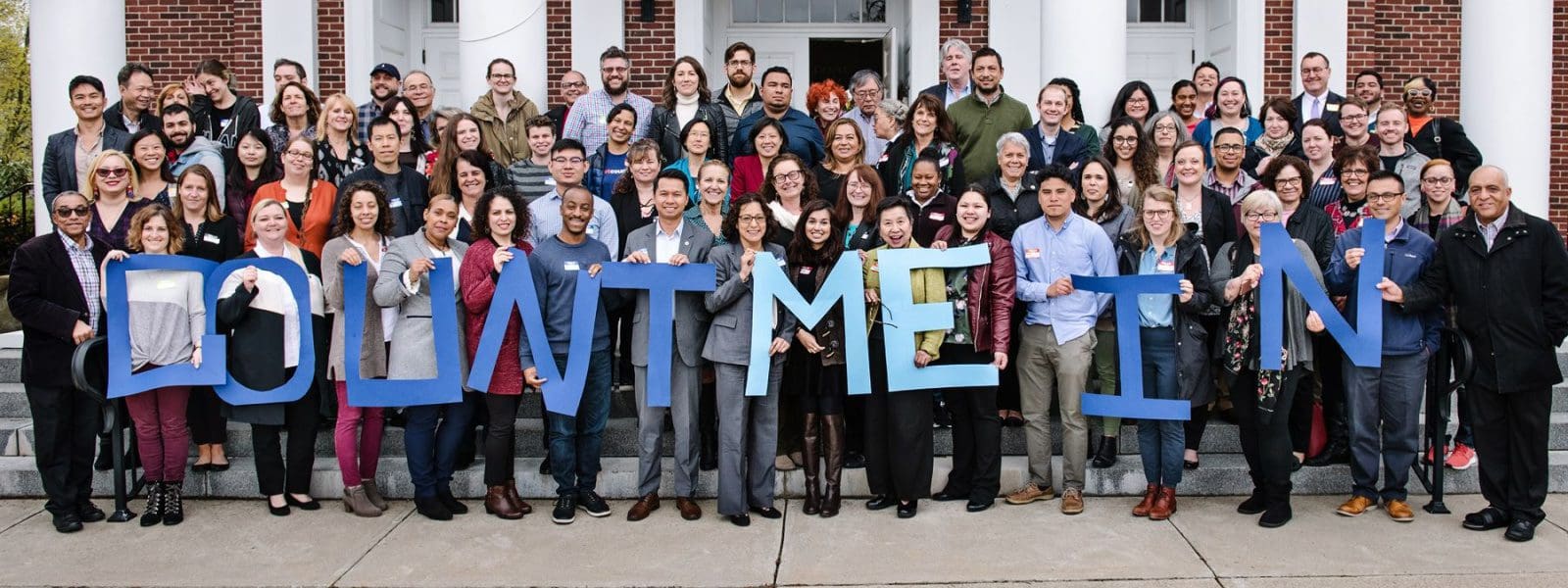As Paul D. Daugherty sees it, West Virginia residents are doing something spectacular: They’re working together to transform areas in the nation’s 35th state for the better – and they’re doing so with community foundations and national philanthropies as trusted partners.
As the Mountain State celebrates its 158th birthday this year, Philanthropy West Virginia – the Morgantown-based leadership network of nearly 90 philanthropic organizations led by Daugherty as president and CEO – issued a new report in June, Transforming Rural: Accelerating Community-Based Philanthropy, to spotlight this bottom-up approach for progress.

Paul D. Daugherty (center) of Philanthropy West Virginia stands with fellow panelists at a recent event. Photo courtesy of Philanthropy West Virginia
“Transforming Rural showcases that when philanthropy centers the needs of the community and focuses on building local leadership and major long-term investments, rural communities can achieve growth and impact,” Daugherty says. “Our work ahead is to continue this momentum as we come out of the pandemic to ensure rural communities are built up better than before.”
The report includes a 20-year look at how the combined asset value of community foundations in West Virginia tripled to $500 million, and how their involvement has grown to play a pivotal role in supporting resident-driven projects, including community revitalization, ensuring food stability and more, in 95% of the state’s 55 counties.
This approach is finding support in West Virginia, which is home to more than 1.7 million people. The state has seen its coal-based economy change over the years because it helps address economic development, pandemic relief, persistent poverty, and other topics that residents say are important to their future.
 This framework, as Daugherty says, also marks a shift in big-picture thinking from scarcity to abundance in West Virginia: “It put a challenge out there to engage donors and envision where the community wanted to be in 5 to 10 years. When you’re in rural areas, you’re often just trying to get through the week, the month, the year. This allows communities to build energy and enthusiasm to be their own problem solvers.”
This framework, as Daugherty says, also marks a shift in big-picture thinking from scarcity to abundance in West Virginia: “It put a challenge out there to engage donors and envision where the community wanted to be in 5 to 10 years. When you’re in rural areas, you’re often just trying to get through the week, the month, the year. This allows communities to build energy and enthusiasm to be their own problem solvers.”
A Look Back and Focus on Listening
In the late 1990s and early 2000s, philanthropic reports documented how rural areas, including West Virginia, were home to wealth-creating industries, but foundation investments went elsewhere, Daugherty says. By the mid- to the late-2000s, a local shift occurred as West Virginia residents organized, identified community topics that needed solutions, and engaged with their local community foundations with some regional and national foundations.
Regional and national funders, organizations, and supporters helped drive this first-step of positive change by taking an important action – they listened. They also made sure more money went to community foundations so collaboration with residents could be possible.

Photo courtesy of Nikki Bowman Mills of New South Media
“The approach of the Claude Worthington Benedum Foundation, Ford Foundation, Appalachian Regional Commission, and the numerous locally based community foundations has transformed the landscape of communities in central Appalachia to now have locally based philanthropic resources that did not exist before,” Daugherty says.
In its Transforming Rural report, Philanthropy West Virginia points to examples of progress, including:
- In 2000, a dozen community foundations in West Virginia had a combined asset value of $125 million and worked in 30 of the state’s counties. By last year, nearly 30 community foundations in the state had a combined asset value of $500 million and worked in all but three of West Virginia’s 55 counties.
- Community foundations in West Virginia also now invest more $18.5 million each year in the state, while still reserving money for the future.
Community foundations are some of the best nonprofit vehicles to devise and implement change, says Dr. Jim Denova, who retired in June as vice president of the Benedum Foundation and served as the senior program officer of this philanthropic initiative in West Virginia.

Photo courtesy of Nikki Bowman Mills of New South Media
“Community foundations provide the means for citizens to identify local problems, and raise the capital to address those problems,” Denova says. “The Benedum Foundation was pleased to support the … initiative in the first decade of this century to expand the network of community foundations in West Virginia and Southwestern Pennsylvania as a ‘bottom-up’ means of engaging individuals in philanthropy while building a sustainable infrastructure for charitable giving.”
Adds Judy Sjostedt, a former Philanthropy West Virginia board chair and current Parkersburg Area Community Foundation executive director: “What began as a grassroots movement of local community foundations as the West Virginia Community Foundations Consortium, grew into West Virginia Grantmakers, and later became Philanthropy West Virginia, received a phenomenal boost when the Benedum Foundation embraced our vision of building community philanthropy across West Virginia. We had big dreams and strong leadership, but lacked resources. We needed a partner who would believe in our work and invest in our infrastructure.”
This community foundation model fits West Virginia and central Appalachia well, Daugherty adds, because it can respond well to different communities that make up the state and region. While areas closer to Ohio are part of the Rust Belt and residents might be dealing with the steel industry, other parts of the state and region might count agriculture, natural gas, and coal as central to their economies.

Photo courtesy of Philanthropy West Virginia
During the height of COVID-19, community foundations issued nearly $3 million in grants to help businesses and nonprofits survive during the economic hardship. The Tucker Community Foundation, based in Parsons, used its grantmaking to support local businesses in its region, such as helping restaurants convert to pick-up and delivery services.
In the Ohio River Valley, residents and community foundations are working with nonprofit and business partners on a career pipeline fellowship program, the Civic Leaders Fellowship Program founded at the Parkersburg Area Community Foundation – so undergraduate and graduate students can build careers in West Virginia and contribute to the region. Young people from West Virginia often leave for jobs elsewhere. Daugherty notes one of many upshots from this fellowship program: Eighty percent of the young people who have completed the program have ended up staying in the region.
He sees focusing on the common good in communities and working with the lived experience as a way forward for the nation at a time when deep political and regional differences remain.
“We can overcome partisan divides if we realize, live, and work the concept of a rural-to-urban continuum and not a divide. That continuum is one where we ensure rural and urban communities grow and thrive together,” he says.
“The work is not done, but it’s a starting point of continued ways to build up places that have been historically left behind by national philanthropy and partners.”
Bradley Wong is director of strategic communications and public relations at Independent Sector. Philanthropy West Virginia, an Independent Sector member, works to strengthen philanthropy in the Mountain State and believes West Virginia has thriving communities, due in part, to a strong and vibrant philanthropic sector. The top photograph is courtesy of Philanthropy West Virginia. Learn about other Independent Sector members and becoming a member.



